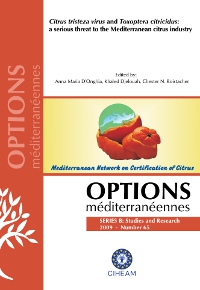| Article précédent | p. 49-56 | Article suivant |
Historical review of Citrus tristeza virus in Portugal
Most of the citrus production in Portugal is located in the Algarve region, in the south, which accounts for almost 70 percent of the national production. A boom of citrus planting occurred in the late 1980s with the introduction of modern varieties. This was accompanied by the introduction of CTV in the plant propagation material. Surveys for the virus and vectors started also at that time accompanied by the eradication of several foci of the disease. In parallel, works aiming at the molecular characterization of the virus were pursued. Up to the year 2000 most of the virus variants found in the orchards were similar to the Spanish predominant variant. Later the appearance of different variants became frequent. In 2005 new foci were detected in the north western part of the country in places where T. citricidus was present. With these new virus variants, the complete set of strains existing at worldwide level is now present in Portugal mainland.
Au Portugal, la production d'agrumes est essentiellement concentrée dans la région de l'Algarve, dans le sud du pays, qui représente presque 70 pour cent du total national. Au cours des années 80, le verger agrumicole a connu un nouvel essor à la suite de l'introduction des variétés modernes. Parallèlement, le CTV a été introduit par le matériel de multiplication. Des enquêtes ont donc été entreprises pour la détection du virus et de ses vecteurs, accompagnées de l'éradication de plusieurs foyers de la maladie. En même temps, la caractérisation moléculaire du virus a été complétée. Jusqu'à l'an 2000, la grande partie des variantes du virus décelées dans les vergers étaient similaires à la variante prédominante en Espagne. D'autres variantes ont ensuite été observées. En 2005, de nouveaux foyers ont été identifiés dans le nord-ouest du pays, dans des régions où le T. citricidus était présent. Après la mise en évidence de ces nouvelles variantes, il est possible de conclure que la gamme complète des souches de CTV connues à l'échelle mondiale est actuellement représentée au Portugal.
- [ Afficher ]
- [ Télécharger ]
- [ Exporter la citation ]
Vous pouvez télécharger la citation au format :
- [ Imprimer ]
-
Mots-clés
AGRUME, CITRUS, CLOSTEROVIRUS TRISTEZA DU CITRUS, HISTOIRE, PORTE GREFFE, PORTUGALCiter cet article
Nolasco G. Historical review of Citrus tristeza virus in Portugal. In : D'Onghia A.M. (ed.), Djelouah K. (ed.), Roistacher C.N. (ed.). Citrus tristeza virus and Toxoptera citricidus: a serious threat to the Mediterranean citrus industry. Bari : CIHEAM, 2009. p. 49-56. (Options Méditerranéennes : Série B. Etudes et Recherches; n. 65). http://om.ciheam.org/om/pdf/b65/00801386.pdf



